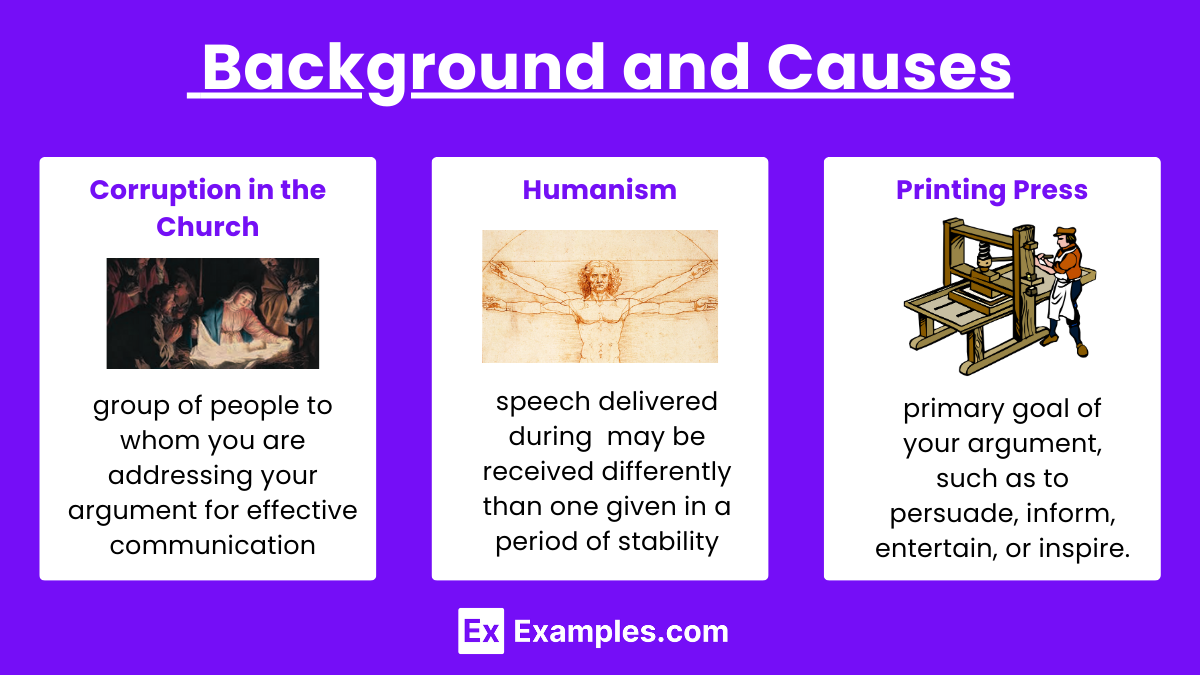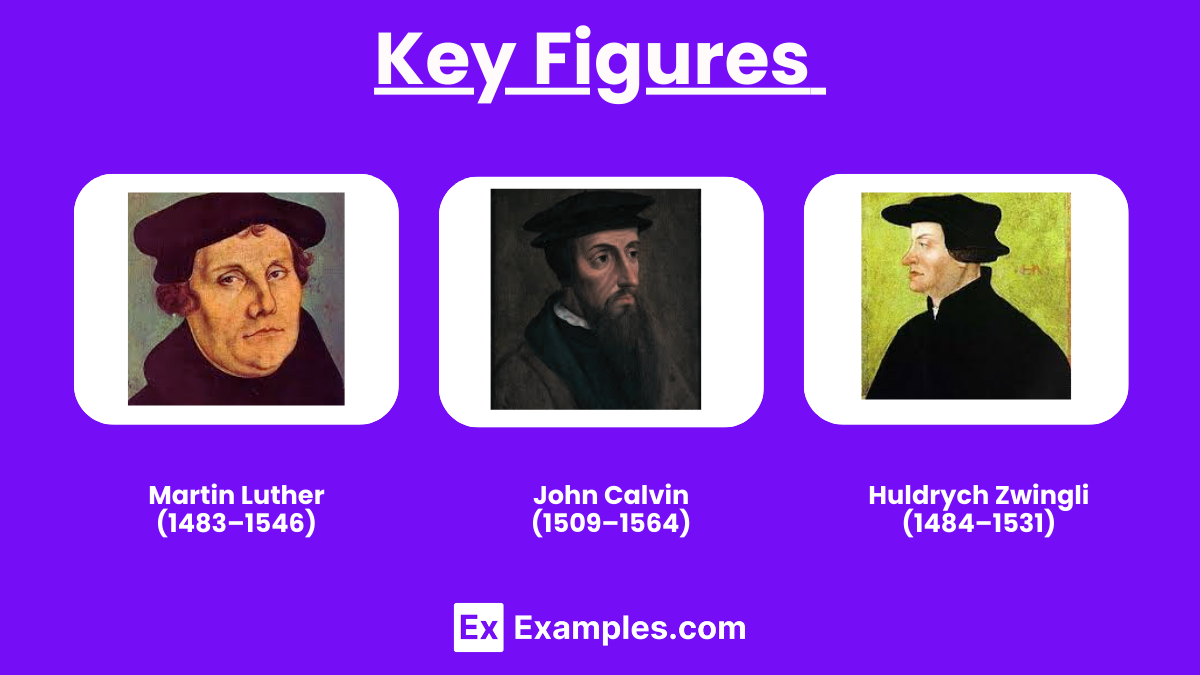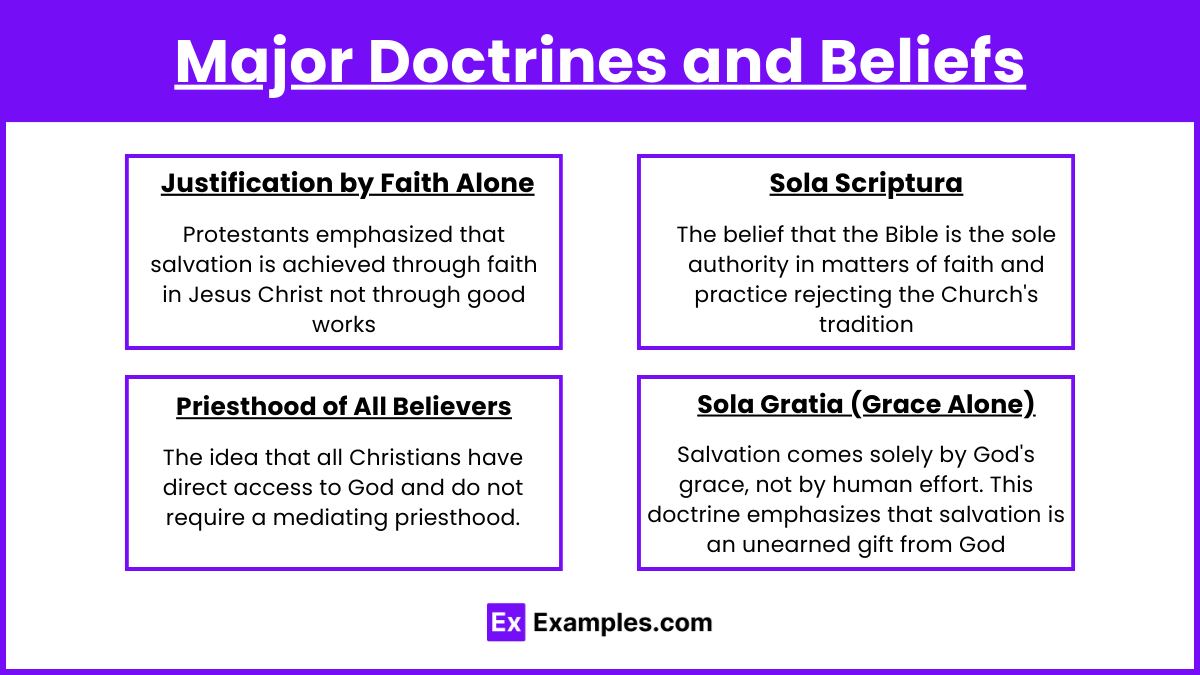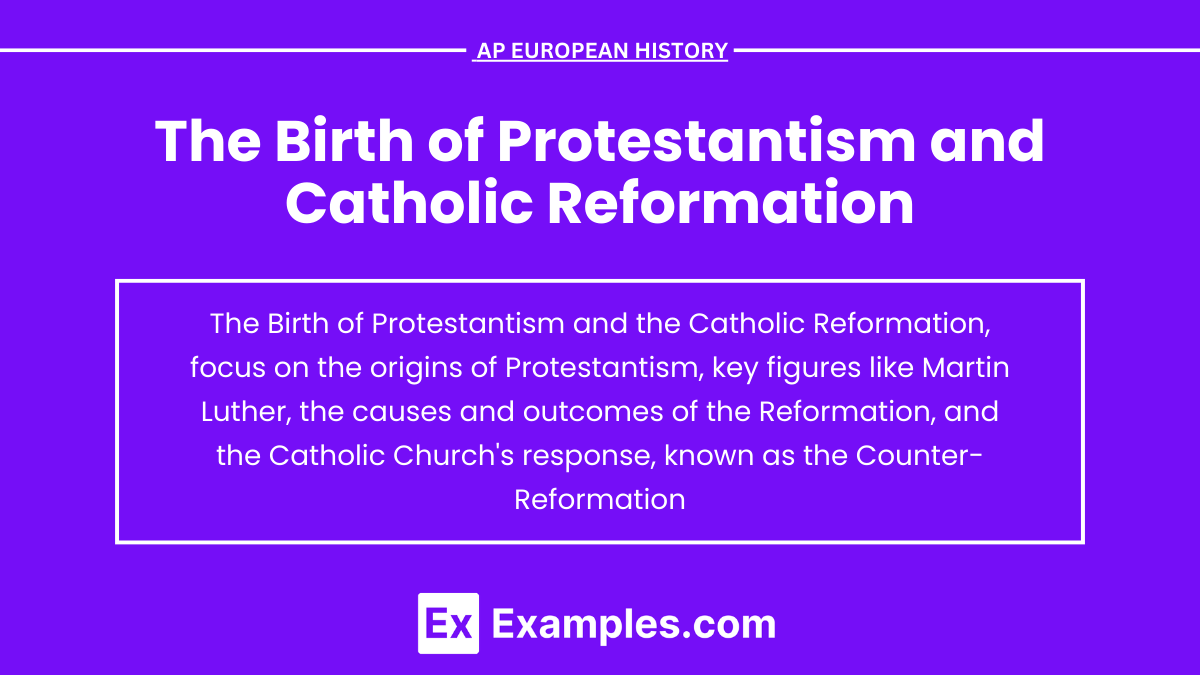The Birth of Protestantism and the Catholic Reformation were pivotal events in European history during the 16th century. Sparked by widespread dissatisfaction with the Catholic Church’s practices and doctrines, these movements led to the creation of Protestant denominations and significant reforms within the Catholic Church. Key figures like Martin Luther and John Calvin played crucial roles in challenging Church authority, while the Catholic Reformation, exemplified by the Council of Trent, sought to address internal corruption and clarify Catholic teachings. These developments reshaped European religious and cultural landscapes.
Learning Objectives
In studying “The Birth of Protestantism and the Catholic Reformation” for the AP European History exam, you should understand the causes and key figures of the Protestant Reformation, including Martin Luther, John Calvin, and Huldrych Zwingli. Recognize the doctrinal changes they proposed, such as justification by faith alone. Grasp the Catholic Church’s response through the Council of Trent and new religious orders like the Jesuits. Analyze the social, political, and cultural impacts of these movements, including religious wars and the influence on art and education.
The Birth of Protestantism
Background and Causes

- Corruption in the Church: The Catholic Church faced criticism for its practices, including the sale of indulgences, simony (selling church offices), and moral corruption among the clergy.
- Humanism and Renaissance Thought: The Renaissance fostered a spirit of inquiry and individualism, leading people to question traditional authority, including that of the Church.
- Printing Press: The invention of the printing press by Johannes Gutenberg in the mid-15th century allowed for the rapid spread of ideas, including criticisms of the Church.
Key Figures

- Martin Luther (1483–1546) : A German monk and theologian, Luther became a central figure in the Reformation. His 95 Theses, posted in 1517, criticized the sale of indulgences and other Church practices.
- John Calvin (1509–1564): A French theologian who established a theocratic government in Geneva, Calvin emphasized predestination and a strict moral code.
- Huldrych Zwingl (1484–1531): A Swiss reformer, Zwingli led a movement in Zurich that rejected traditional Catholic practices, such as the Mass and the veneration of saints.
Major Doctrines and Beliefs

- Justification by Faith Alone: Protestants emphasized that salvation is achieved through faith in Jesus Christ, not through good works or Church sacraments.
- Sola Scriptura: The belief that the Bible is the sole authority in matters of faith and practice, rejecting the Church’s tradition as equally authoritative.
- Priesthood of All Believers: The idea that all Christians have direct access to God and do not require a mediating priesthood.
- Sola Gratia (Grace Alone): Salvation comes solely by God’s grace, not by human effort. This doctrine emphasizes that salvation is an unearned gift from God, underscoring the belief in divine sovereignty in the process of salvation.
Spread and Impact:
- Political Support: Many rulers and princes supported the Reformation, seeing it as a way to assert independence from the Pope and gain control over church lands and wealth.
- Peasant Revolts: The Reformation inspired various social and political movements, including the Peasants’ War in Germany, as common people interpreted Luther’s ideas as a call for social justice.
- Wars of Religion: The spread of Protestantism led to religious conflicts, including the Thirty Years’ War (1618-1648), which devastated much of Europe.
The Catholic Reformation (Counter-Reformation)
1. The Council of Trent (1545-1563):
- Doctrinal Clarification: The Council reaffirmed Catholic doctrines, such as the authority of the Pope, the necessity of sacraments, and the role of good works in salvation.
- Reform of Church Practices: Measures were taken to address corruption, including the establishment of seminaries for the proper training of priests and stricter enforcement of clerical celibacy.
2. New Religious Orders:
- The Jesuits: Founded by Ignatius of Loyola, the Society of Jesus (Jesuits) became a leading force in the Counter-Reformation, focusing on education, missionary work, and the defense of Catholic doctrine.
- The Ursulines: A religious order dedicated to the education of girls, promoting moral and religious education.
3. The Inquisition and Censorship:
- Roman Inquisition: Aimed at combating heresy, the Roman Inquisition prosecuted those suspected of Protestant beliefs or other heresies.
- Index of Forbidden Books: The Church published a list of prohibited books to prevent the spread of Protestant ideas.
4. Art and Culture:
- Baroque Art: The Catholic Church used Baroque art and architecture to inspire awe and communicate religious themes, seen in the works of artists like Caravaggio and Bernini.
- Catholic Mysticism: Figures like St. Teresa of Avila and St. John of the Cross emphasized deep personal experiences of God, often through visions and mystical writings.
Cultural and Political Impact of the Catholic Reformation
- Baroque Art and Architecture: The Catholic Church promoted Baroque art, characterized by dramatic imagery and grandeur, with notable artists like Caravaggio and architects like Bernini.
- Music and Literature: Sacred music by composers like Palestrina emphasized devotion, while mystical literature by St. Teresa of Ávila and St. John of the Cross focused on personal spirituality.
- Education: The Jesuits established schools to promote Catholic doctrine and classical education.
- Religious Wars: Conflicts like the Thirty Years’ War were fueled by religious differences, ending with the Peace of Westphalia and promoting state sovereignty.
- Political Realignment: Religious divisions led to new political alliances and rivalries across Europe, reshaping its political landscape.
The Protestant Reformation and the Catholic Reformation were complex and multifaceted movements that fundamentally changed the religious and political fabric of Europe. The Reformation challenged the authority of the Catholic Church, leading to the formation of new Christian denominations, while the Counter-Reformation sought to reform and strengthen the Catholic Church from within. These movements not only shaped religious beliefs but also influenced social, cultural, and political developments in Europe and beyond.
The Birth of Protestantism and the Catholic Reformation: 5 Key Examples
- Martin Luther’s Ninety-Five Theses (1517): Criticized the Catholic Church’s practices, sparking the Protestant Reformation.
- Formation of the Anglican Church (1534): King Henry VIII established the Church of England, separating from the Catholic Church.
- Council of Trent (1545-1563): A major Catholic reform council that addressed corruption and reaffirmed doctrines.
- Spread of Calvinism: John Calvin’s teachings spread widely, influencing regions like Scotland and parts of France.
- Jesuit Order’s Role: Founded by Ignatius of Loyola, the Jesuits were crucial in the Catholic Reformation through education and missionary work.
Practice Questions on The Birth of Protestantism and the Catholic Reformation
Question 1 : Which event is commonly considered the beginning of the Protestant Reformation?
- A. The signing of the Treaty of Westphalia
- B. The posting of the Ninety-Five Theses by Martin Luther
- C. The Council of Trent
- D. The founding of the Jesuit order
Answer: B. The posting of the Ninety-Five Theses by Martin Luther
Explanation: The Protestant Reformation is often marked by the event in 1517 when Martin Luther, a German monk and theologian, posted his Ninety-Five Theses on the door of the Wittenberg Castle Church. This document criticized the Catholic Church’s practice of selling indulgences and questioned the authority of the Pope, sparking widespread religious reform and the birth of Protestantism.
Question 2 : Which of the following was a key outcome of the Council of Trent?
- A. The establishment of the Anglican Church
- B. The reaffirmation of traditional Catholic doctrines
- C. The endorsement of Martin Luther’s teachings
- D. The spread of Calvinism in Europe
Answer: B. The reaffirmation of traditional Catholic doctrines
Explanation: The Council of Trent (1545-1563) was a significant part of the Catholic Reformation, also known as the Counter-Reformation. It addressed the challenges posed by the Protestant Reformation and aimed to clarify Catholic doctrines. The Council reaffirmed traditional teachings such as the necessity of both faith and works for salvation, the seven sacraments, and the authority of the Pope. It also initiated reforms to address corruption and improve the education of clergy.
Question 3 : What role did the printing press play in the Protestant Reformation?
- A. It spread the works of Catholic reformers like Ignatius of Loyola
- B. It was used to print and disseminate indulgences more widely
- C. It allowed for the rapid spread of Martin Luther’s ideas and writings
- D. It facilitated the translation of the Bible into Latin
Answer: C. It allowed for the rapid spread of Martin Luther’s ideas and writings
Explanation: The invention of the printing press by Johannes Gutenberg in the mid-15th century played a crucial role in the spread of the Protestant Reformation. It enabled Martin Luther’s ideas and writings, such as his Ninety-Five Theses, to be printed and distributed quickly and widely. This helped disseminate Reformation ideas across Europe, challenging the Catholic Church’s teachings and practices and making religious texts more accessible to the general public.


